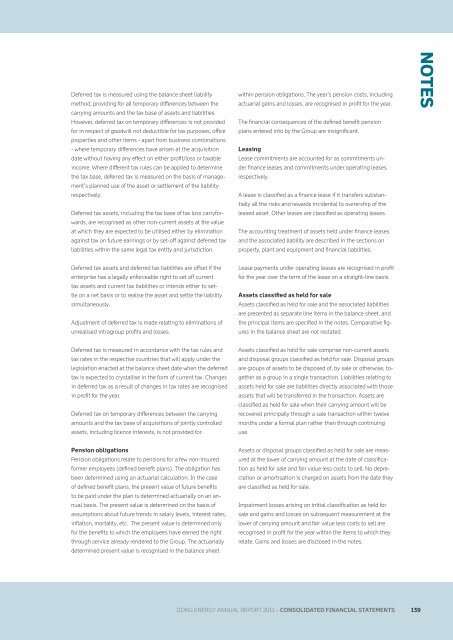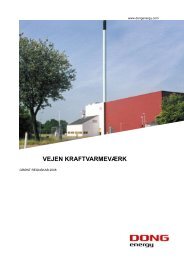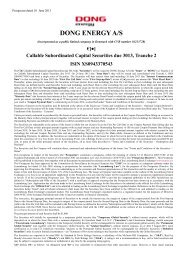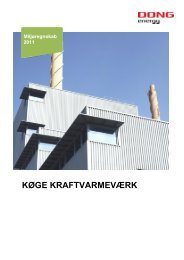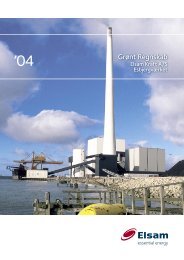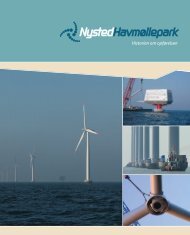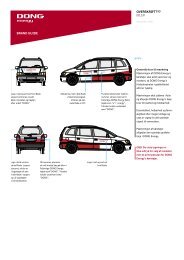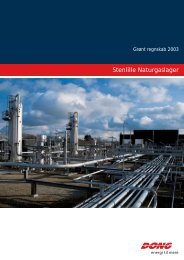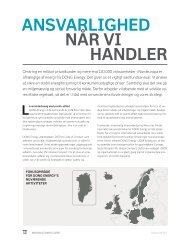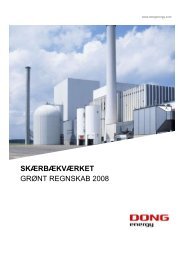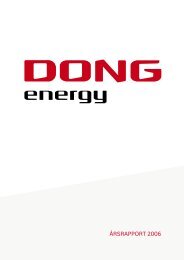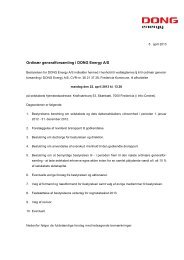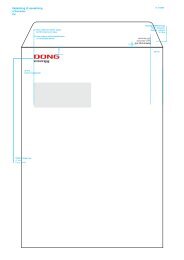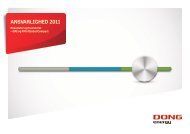ANNUAL REPORT 2011 - DONG Energy
ANNUAL REPORT 2011 - DONG Energy
ANNUAL REPORT 2011 - DONG Energy
Create successful ePaper yourself
Turn your PDF publications into a flip-book with our unique Google optimized e-Paper software.
Deferred tax is measured using the balance sheet liability<br />
method, providing for all temporary differences between the<br />
carrying amounts and the tax base of assets and liabilities.<br />
However, deferred tax on temporary differences is not provided<br />
for in respect of goodwill not deductible for tax purposes, office<br />
properties and other items - apart from business combinations<br />
- where temporary differences have arisen at the acquisition<br />
date without having any effect on either profit/loss or taxable<br />
income. Where different tax rules can be applied to determine<br />
the tax base, deferred tax is measured on the basis of management’s<br />
planned use of the asset or settlement of the liability<br />
respectively.<br />
Deferred tax assets, including the tax base of tax loss carryforwards,<br />
are recognised as other non-current assets at the value<br />
at which they are expected to be utilised either by elimination<br />
against tax on future earnings or by set-off against deferred tax<br />
liabilities within the same legal tax entity and jurisdiction.<br />
Deferred tax assets and deferred tax liabilities are offset if the<br />
enterprise has a legally enforceable right to set off current<br />
tax assets and current tax liabilities or intends either to settle<br />
on a net basis or to realise the asset and settle the liability<br />
simultaneously.<br />
Adjustment of deferred tax is made relating to eliminations of<br />
unrealised intragroup profits and losses.<br />
Deferred tax is measured in accordance with the tax rules and<br />
tax rates in the respective countries that will apply under the<br />
legislation enacted at the balance sheet date when the deferred<br />
tax is expected to crystallise in the form of current tax. Changes<br />
in deferred tax as a result of changes in tax rates are recognised<br />
in profit for the year.<br />
Deferred tax on temporary differences between the carrying<br />
amounts and the tax base of acquisitions of jointly controlled<br />
assets, including licence interests, is not provided for.<br />
pension obligations<br />
Pension obligations relate to pensions for a few non-insured<br />
former employees (defined benefit plans). The obligation has<br />
been determined using an actuarial calculation. In the case<br />
of defined benefit plans, the present value of future benefits<br />
to be paid under the plan is determined actuarially on an annual<br />
basis. The present value is determined on the basis of<br />
assumptions about future trends in salary levels, interest rates,<br />
inflation, mortality, etc. The present value is determined only<br />
for the benefits to which the employees have earned the right<br />
through service already rendered to the Group. The actuarially<br />
determined present value is recognised in the balance sheet<br />
within pension obligations. The year’s pension costs, including<br />
actuarial gains and losses, are recognised in profit for the year.<br />
The financial consequences of the defined benefit pension<br />
plans entered into by the Group are insignificant.<br />
leasing<br />
Lease commitments are accounted for as commitments under<br />
finance leases and commitments under operating leases<br />
respectively.<br />
A lease is classified as a finance lease if it transfers substantially<br />
all the risks and rewards incidental to ownership of the<br />
leased asset. Other leases are classified as operating leases.<br />
The accounting treatment of assets held under finance leases<br />
and the associated liability are described in the sections on<br />
property, plant and equipment and financial liabilities.<br />
Lease payments under operating leases are recognised in profit<br />
for the year over the term of the lease on a straight-line basis.<br />
assets classified as held for sale<br />
Assets classified as held for sale and the associated liabilities<br />
are presented as separate line items in the balance sheet, and<br />
the principal items are specified in the notes. Comparative figures<br />
in the balance sheet are not restated.<br />
Assets classified as held for sale comprise non-current assets<br />
and disposal groups classified as held for sale. Disposal groups<br />
are groups of assets to be disposed of, by sale or otherwise, together<br />
as a group in a single transaction. Liabilities relating to<br />
assets held for sale are liabilities directly associated with those<br />
assets that will be transferred in the transaction. Assets are<br />
classified as held for sale when their carrying amount will be<br />
recovered principally through a sale transaction within twelve<br />
months under a formal plan rather than through continuing<br />
use.<br />
Assets or disposal groups classified as held for sale are measured<br />
at the lower of carrying amount at the date of classification<br />
as held for sale and fair value less costs to sell. No depreciation<br />
or amortisation is charged on assets from the date they<br />
are classified as held for sale.<br />
Impairment losses arising on initial classification as held for<br />
sale and gains and losses on subsequent measurement at the<br />
lower of carrying amount and fair value less costs to sell are<br />
recognised in profit for the year within the items to which they<br />
relate. Gains and losses are disclosed in the notes.<br />
<strong>DONG</strong> ENERGY <strong>ANNUAL</strong> <strong>REPORT</strong> <strong>2011</strong> – COnsOliDatED finanCial statEmEnts<br />
139<br />
notes


